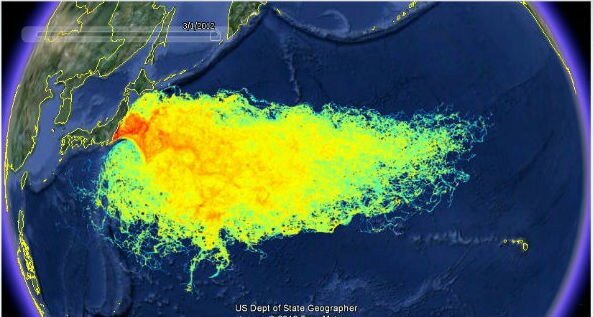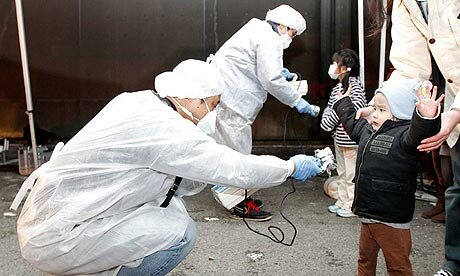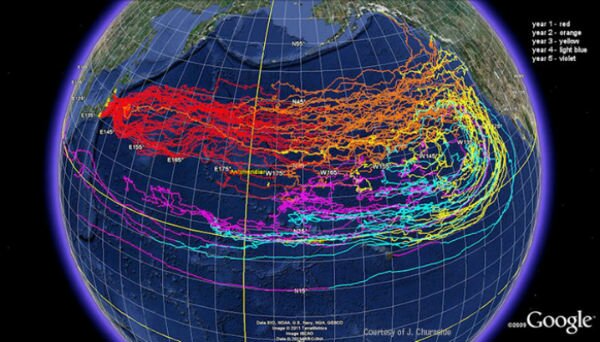Radioactive Food and Water the New Normal in Japan
(and everywhere else)
(and everywhere else)
by Richard
Wilcox, PhD
“We forget that the water cycle and the life
cycle are one.”
— Jacques
Cousteau
Japan has an amazing food culture thanks in part to the rich volcanic soil and ample rainfall, despite the lack of spacious farms. As it stands, Japan can feed approximately one third of its population from domestic production.
If you watch Japanese TV from time to time, you will see a bizarre and disturbing fetishization of food that borders on the insane. The media and in turn consumers are obsessed with food as not only a source of nutrition and social cohesion (all for the good), but as art, fashion and status symbol, a celebration of gluttony and greed; an infantile obsession with eating for self satisfaction.
I love good and healthy food and appreciate Asian cuisine, but we eat to live, not live to eat. This social pathology affects other cultures as well as seen by increasing rates of extreme obesity especially in Western countries due to the proliferation of shopping malls, junk food and high fructose corn syrup.
How ironic then that a “high food” society like Japan would have to suffer the insult of radioactive contamination. This is not a tuna melt sandwich but a nuclear melt-down sundae.
“Ye shall know them by their fruits. Do men gather grapes of thorns, or figs of thistles?
Even so every good tree bringeth forth good fruit; but a corrupt tree bringeth forth evil fruit.
A good tree cannot bring forth evil fruit, neither can a corrupt tree bring forth good fruit.
Every tree that bringeth not forth good fruit is hewn down, and cast into the fire.
Wherefore by their fruits ye shall know them.”
— Matthew 7:16-20, Holy Bible
Radiation Nation
The long-term consequences of the Fukushima nuclear disaster continue to linger years after the event. Anyone who studies Chernobyl will know that even after three decades radioactive contamination persists. Although a different type of accident occurred there, in the case of Fukushima it was three reactors that had meltdowns instead of one, and even possibly “melt throughs” referring to corium penetrating the reactor buildings in lateral and vertical outward paths.
In the days and months that followed the Fukushima disaster in March of 2011, many people became very worried about radioactive contamination of the food and water supply, especially from short-lived iodine isotopes, followed by the more persistent and harmful cesium, strontium and plutonium. There was much testing by both the government and independent researchers and organizations. Despite the best efforts of the Japanese government, nuclear industry and mainstream media to downplay the crisis, social media proved helpful in educating the public about how to reduce consumer risks.
The worst contamination occurred nearest the disaster site of the Fukushima No. 1 nuclear power station (Dai-ichi) which is located about half way up the east coast in Fukushima prefecture.
When I visited Hirano town with my colleague Yoichi Shimatsu in 2013, we traveled on foot within a few kilometers of the site. We observed abnormally high levels of radiation making it unfit for long-term habitation. Decontamination has taken place there but it is not a thorough removal method and basically shifts radiation from one spot to another in the environment.
Today, if you visit the Japanese government website of the Nuclear Regulation Authority (1) you can find a variety reports on radiation levels with most reports citing very low levels of radiation. How the government arrives at such measurements is not clearly explained at the website. Are their measurements reliable or being taken in a selective manner?
The government hopes to normalize the former evacuation zone by allowing and encouraging residents to move back as soon as possible, despite their reluctance to do so.
Only 28% of Fukushima children returning to former schools….
The majority of schoolboys and girls are opting to stay out of their hometowns due to anxiety over radiation exposure and resettlement at evacuation sites (2).
The problem of radioactive contamination is not unique to Fukushima but to the entire region including Tokyo, home of millions. Recall that 60 million people were originally exposed to radioactive fallout from the accident. Japan was actually lucky because the majority of radiation blew out to sea away from Honshu, not back over the population.
While the government moves to allow wide-scale fishing off the coast of Fukushima (3), and the NRA reports minimal levels of radiation leaking from the plant into the ocean, this confidence in a safe environment is undermined by a report from Greenpeace which found “[r]adiation along Fukushima rivers up to 200 times higher than Pacific Ocean seabed.”
Riverbank sediment samples taken along the Niida River in Minami Soma, measured as high as 29,800 Bq/kg for radiocaesium (Cs-134 and 137). The Niida samples were taken where there are no restrictions on people living, as were other river samples. At the estuary of the Abukuma River in Miyagi prefecture, which lies more than 90km north of the Fukushima Daiichi plant, levels measured in sediment samples were as high as 6,500 Bq/kg (4).
The rivers and ocean are connected and one wonders why the media does not report on these worrying hotspots. These dangerously high levels are indicative of the widely scattered hotspots in the region. In contrast, I could find no reports on the radiation levels at river banks and lake beds at the NRA website, only some reports on radiation found in dust, seawater and so on.
For example, one 2014 report states:
Air dose rates in both “Road and its adjacent area” and “Vacant land lot” have decreased more rapidly than we expected considering the physical half-life of radionuclide in 32 months after the accident. Air dose rates in “Road and its adjacent area” have decreased more rapidly than “Vacant land lot” in 32 months after the accident (5).
The Culture Of Cover Up: Spiked!
A few months ago I was shopping at my health food store in central Tokyo when I was asked by the clerk if I would like to be interviewed by a TV reporter from the Asahi News. I said “sure why not.” Japanese TV often has “man on the street” types of interviews and if you put the shop in a good light, you might appear in a news “infomercial.”
The reporter asked me various questions about why I buy organic food and I spoke proficiently in Japanese about the positive benefits of eating organic food including its superior nutrition and flavor, and because it contributes to the local farm economy.
“When drinking water, remember its source.”
—
Chinese proverb
But I shocked the guy at this point when I bluntly stated that due to the radioactive contamination from Fukushima nuclear disaster, I prefer to buy food produced from as far away as possible, never from the northeast or Tokyo regions of Japan. Food from the west and far southwest of Japan has substantially less radioactive contamination.
I’m not sure if the reporter was even aware of the issue, being a “news reporter” you think he might have been. But it was clear from his reaction that this was a one hundred percent taboo topic. Perhaps because I was a foreigner I was perceived as rude and barbaric for raising it, and I knew ahead of time that by mentioning this my interview would not be aired, and it wasn’t.
In fact, after the 3/11 accident my regular health food shop very noticeably shifted the origin of their produce away from the northeast and Tokyo and toward the west, southwest of Japan due to consumer concerns. As for the Asahi News who are an arm of the Abe Propaganda Establishment (APE), Fukushima must only be presented to the public as a pristine location whose products are reliable and safe. A recent study reported:
According to the agriculture ministry, 260,538 food items were inspected in fiscal 2015, and 99 percent of farm products had cesium of less than 25 becquerels per kilogram. The tests showed that 264 items, or 0.1 percent of the total, had cesium exceeding the upper limit. Of these, 259 — or 98 percent — were wild mushrooms, game meat, freshwater fish and other so-called “hard-to-control items” (6).
According to this official data, small numbers of becquerels could be – probably are – routinely entering the general food supply, not to mention the issue of Tokyo’s persistently contaminated water supply which contains minute amounts of cesium.
Radiation
is the new normal.
Although the majority of food is under 25 bq per kg of contamination, we don’t know the exact amount. If you multiply that small amount by the number of items consumed daily the danger to health grows exponentially over time.
It is good that Japan has strict standards on radioactive food products — the US allows 1,500 becquerels per kilogram versus Japan’s 100 — but the ubiquitous and long-term aspect of the problem is an ongoing concern.
About the Author
Richard Wilcox is a contributing editor and writer for the book: Fukushima: Dispossession or Denuclearization? (2014) and a Tokyo-based teacher and writer who holds a PhD in environmental studies. He is a regular contributor to Activist Post. His radio interviews and articles are archived athttp://wilcoxrb99.wordpress.com and he can be reached at wilcoxrb2013@gmail.com.
References:
1 – Nuclear Regulation Authority
http://radioactivity.nsr.go.jp/en/
2 – Only 28% of Fukushima children returning to former schools
http://mainichi.jp/english/articles/20160910/p2a/00m/0na/001000c
3 – 83 species now eligible for test fishing off coast of Fukushima
http://www.asahi.com/ajw/articles/AJ201609110002.html
4 – Radiation along Fukushima rivers up to 200 times higher than Pacific Ocean seabed – Greenpeace
http://www.greenpeace.org/international/en/press/releases/2016/Radiation-along-Fukushima-rivers-up-to-200-times-higher-than-Pacific-Ocean-seabed—Greenpeace/
5 – Monitoring air dose rates in road/its adjacent area and vacant land lot from a series of surveys by car-borne radiation detectors and survey meters after the Fukushima Daiichi NPS accident
https://www.nsr.go.jp/data/000067236.pdf
6 – 0.1% of food items exceed radiation limit 5 1/2 years after nuke disaster
http://mainichi.jp/english/articles/20160909/p2a/00m/0na/023000c
From Waking Times @ http://www.wakingtimes.com/2016/09/14/radioactive-food-water-new-normal-japan/
Fukushima Has Now Contaminated One Third of the World’s Oceans

by Sophia Akram
The
International Atomic Energy Agency (IAEA), seeking to promote the peaceful use of Nuclear Power, in 2011
established with the Regional
Cooperative Agreement (RCA) Member States, a joint IAEA
Technical Cooperation (TC) project in the region of the Pacific Ocean.
It was established after the Fukushima
disaster when a tsunami caused by a major earthquake on 11 March 2011,
disabled the power supply and cooling of three Fukushima Daiichi reactors,
causing a nuclear accident. As a result a large quantity of radioactive
material was admitted into the Pacific Ocean.

Of no
surprise, this caused great concern to countries based around the Pacific Ocean
due to the potential economic and environmental implications. The TC project’s
aim was therefore, to monitor the presence of radioactive substances in the
marine environment.
The first
annual review meeting held in August 2012 demonstrated predictive hydrodynamic
models and they predicted that the strong current, known as the Kuroshio
Current and its extension, had the ability to transport the radioactive
substances across the Pacific Ocean in an easterly direction. However, the
concentration of radioactivity was not as high as originally thought.

A
field study found that two filter cartridges were coated, which showed elements
of cesium, a radioactive substance.
The TC is
due to conclude this year. A few results have caused concern. A field
study they conducted on 2 July
2014, revealed from two sets of seawater samples, found that
two filter cartridges were coated, which showed elements of cesium, a
radioactive substance.
Then
recently, trace amounts of cesium-134 and cesium-137 turned up in samples
collected near Vancouver Island in British
Columbia. The samples collected were separate from the monitoring project
set up by IAEA
but it is thought the only possible source of these radioactive elements is
Fukushima, according to the Integrated
Fukushima Ocean Radionuclide Monitoring(InFORM) Network. This
is the first time that traces of cesium-134 had been detected near North America .
While these
are trace amounts, the danger of radioactive material in any amount cannot be
underestimated. However, the experts say that these levels detected cannot
really harm us, they are still lower than those we could be exposed to from a
dental x-ray for instance.
Having said
that, every possible exposure, in any small amount, adds up. The problem with
nuclear energy and fallout, the radiation and radioactive materials can
travel far and wide with the wind and with the sea. Therefore, we should aim on
a global level to keep these levels at zero. In any event the continuous
monitoring of oceans will need to be conducted, according to Ken Buesseler, a
marine chemist at Woods Hole Oceanographic
Institute.
What
Buesseler says should be taken on board beyond 2015, particularly since the
advice from the IAEA is to dump even
more contaminated water into the sea. This is apparently more desirable than
holding it in tanks. Any discharge will have to be controlled and continuous
monitoring would be needed, in particular near the plant to improve data
reliability. This is causing concern and not just to state authorities.
Consider the fishermen. Every time they catch fish in the ocean, the fish need
to be tested for radioactivity.
Before any
further dumping is done, the IAEA and Tokyo Electric Power Co., who control the
plant, need to consider not only the environmental impact but socio-economic
impact as well. Livelihoods could be affected as well as long-term health of
the region and global community eventually.
From Anonymous @ http://www.anonews.co/fukushima-ocean/
Radiation from Fukushima Now Causes 100% Infant Mortality Rate in West Coast Orcas
The tragedy of Fukushima has been ongoing
since 2011,
but the death of our oceans has been on slow burn for decades.
In 2008, the Scientific American reported that there were 406 dead zones — meaning there was not enough oxygen to support life — worldwide. At that time, the blame was from fertilizer and pesticide runoff.
In 2010, scientists lamented the stunning amount of toxic and heavy metals — including aluminum, chromium, titanium, mercury, silver and lead — discovered in whales that lived thousands of miles away from civilization.
According to a report by Common Dreams, these “pollutants were threatening the human food supply.”
In 2008, the Scientific American reported that there were 406 dead zones — meaning there was not enough oxygen to support life — worldwide. At that time, the blame was from fertilizer and pesticide runoff.
In 2010, scientists lamented the stunning amount of toxic and heavy metals — including aluminum, chromium, titanium, mercury, silver and lead — discovered in whales that lived thousands of miles away from civilization.
According to a report by Common Dreams, these “pollutants were threatening the human food supply.”
Fast forwarding to today, five years past that fateful day in Fukushima, the struggling orca (killer whale) population is in even worse shape. Are they headed for extinction?
Natural News reports, "... the incidence of orca deaths — not just of infants, but full-grown specimens as well — has risen sharply since the accident occurred in 2011 and as the radiation has made its way across the Pacific Ocean to the West Coast of North America...
"Aside from the 100 percent mortality rate among orca infants, many of the matriarchs are dying as well, leading some to speculate that the species may become extinct — possibly within the next 20 years.

“The discovery of an orca carcass off the coast of British Columbia — that of a 19-year-old orca female, which was believed to be in the late stages of pregnancy, is just one example of the recent orca deaths that have scientists and conservationists worried. . .
“Ken Balcomb, executive director of the Center For Whale Research in Friday Harbor, Washington, said: ‘We haven’t had any survivals in babies for a couple of years. We have had stillborns and newborns die... It’s like zero survival in birth rate here.'”
Sources: EPA Watch; Scientific American; Natural News
From Humans Are Free @ http://humansarefree.com/2016/09/radiation-from-fukushima-now-causes-100.html
For more information about FukUshima see http://nexusilluminati.blogspot.com/search/label/Fukushima
- Scroll down
through ‘Older Posts’ at the end of each section
Do you LIKE this uniquely informative site?
Hours of effort by a genuinely incapacitated invalid are
required every day to maintain, write, edit, research, illustrate, moderate and
publish this website
from a tiny cabin in a remote forest.
Now that most people use ad blockers and view these posts
on phones and other mobile devices, sites like this earn an ever shrinking
pittance from advertising sponsorship.
This site needs your help.
Like what you see? Please give anything you can -
Contribute any amount and receive at least one
New Illuminati eBook!
(You can use a card securely if you don’t use Paypal)
Please click below -
And it costs nothing
to share this post on Social Media!
Dare to care and
share - YOU are our only advertisement!
Xtra
image by R. Ayana - https://c2.staticflickr.com/6/5489/11191129216_a93f745beb_k.jpg
For further enlightening
information enter a word or phrase into the random synchronistic search box @
the top left of http://nexusilluminati.blogspot.com
And see
New Illuminati – http://nexusilluminati.blogspot.com
New Illuminati on Facebook - https://www.facebook.com/the.new.illuminati
New Illuminati Youtube Channel - https://www.youtube.com/user/newilluminati/playlists
New Illuminati’s OWN Youtube Videos
-
New Illuminati on Google+ @ For
New Illuminati posts - https://plus.google.com/u/0/+RamAyana0/posts
New Illuminati on Twitter @ www.twitter.com/new_illuminati
New Illuminations –Art(icles) by
R. Ayana @ http://newilluminations.blogspot.com
The Her(m)etic Hermit - http://hermetic.blog.com
DISGRUNTLED SITE ADMINS PLEASE NOTE –
We provide
a live link to your original material on your site (and links via social
networking services) - which raises your ranking on search engines and helps
spread your info further!
This site
is published under Creative Commons (Attribution) CopyRIGHT (unless an
individual article or other item is declared otherwise by the copyright
holder). Reproduction for non-profit use is permitted & encouraged - if you
give attribution to the work & author and include all links in the original
(along with this or a similar notice).
Feel free
to make non-commercial hard (printed) or software copies or mirror sites - you
never know how long something will stay glued to the web – but remember
attribution!
If you
like what you see, please send a donation (no amount is too small or too large)
or leave a comment – and thanks for reading this far…
Live long
and prosper! Together we can create the best of all possible worlds…
From the New Illuminati – http://nexusilluminati.blogspot.com



Recent typhoons knocked out the "ice wall" designed to stop the 300 tons of radiation into the Pacific. Arnie Gunderson, nuclear plant expert visited Tokyo this past summer, and discovered soil samples tested high in radiation, this was after the top soil had been removed year earlier. Jim Hansen, the "father of climate change" was shilling for more nuclear energy plants to be built at COP21 in Paris in 2015. What does that tell an astute person? So incredibly sad what is happening to the sea life.
ReplyDelete